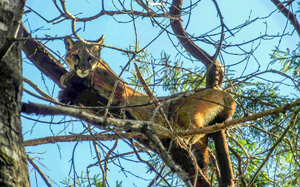Campus News
GPS collar documents puma’s travels from mountains to Mountain View
Forty-six m (46m) is a young puma on the move. A GPS tracking collar that UC Santa Cruz scientists placed around his neck reveals his journey into suburban Silicon Valley.




Forty-six m (46m) is a young puma on the move. A GPS tracking collar that UC Santa Cruz scientists placed around his neck reveals exactly where he goes.
The adolescent’s effort to stretch his legs and establish his own territory took him into the heart of downtown Mountain View earlier this week. Chris Wilmers, UCSC associate professor of environmental studies, points to an on-screen map in his office that shows how 46m took off two weeks ago from his mom’s territory near Big Basin in the Santa Cruz Mountains, a behavior known as “dispersal.”
Wilmers is able to provide a detailed look at 46m’s travels from data downloaded from the collar after he tranquilized him with a dart in the garage of a Mountain View apartment building Tuesday evening (May 6). The collar, developed by UCSC scientists records and transmits data about the animals movements.
Wilmers recounts 46m’s journey in a blog post at Santa Cruz Puma Project’s website. The puma project is a joint study by UC Santa Cruz and the California Department of Fish and Wildlife that follows mountain lions in the Santa Cruz mountains as they negotiate the intersections of natural habitat and human intrusion. Wilmers said 13 or 14 pumas are being tracked currently.
The cat had spent more than two days in Mountain View, keeping himself hidden until he made a break for it. Data show he spent several daylight hours Tuesday hunkered down in some bushes alongside an apartment building. Pedestrians and motorists just feet away were none the wiser.
“He spent two nights and parts of three days wandering around this highly developed area, and no one had seen him,” Wilmers said.
GPS data show the puma first moved north from his home territory April 24, then east, eventually crossing Interstate 280 before dropping into Mountain View.
The mountain lion’s suburban escapade attracted several hundred spectators as Mountain View police blocked the area, sent out text alerts, and trained their rifles on the animal hiding under a parked car.
“Mountain View police and Cal Fish and Wildlife did a great job of safely anesthetizing and relocating this animal back into open space,” Wilmers said.
Wilmers and his team first captured and collared 46m in January. He’s between 18 months and 2 years old and weighed 93 pounds when first collared. His brother 41m was captured and collared last October. Remote video taken before researchers arrived at the capture site showed 46m teasing his brother inside a cage baited with a deer carcass. Other video in February shows 46m feeding on a deer alongside his uncollared mom.
After 46m’s second capture, Wilmers and his team transported the puma back into the Santa Cruz Mountains where he will resume his quest for a territory of his own. Wilmers said data from the collar will continue to show his whereabouts.
When in range the data are transmitted via cellular telephone sites as texts; 46M is now a member of the Wilmers family cell phone plan.